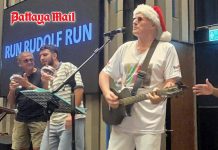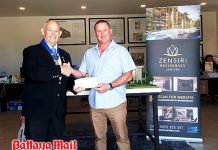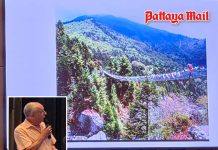Relieve pain using your own blood. When you have pain from damaged cartilages in your knees, or arthritic knees, or tears in other ligaments and tendons, there is a treatment that may bring you relief that does not involve surgery or medicines. It is called platelet-rich plasma (PRP) and it was the topic of a presentation by Dr. Peter Lewis, MD and colleagues at the Sunday, November 30 meeting of the Pattaya City Expats Club (PCEC).
Dr Peter Lewis is an Australian sports medicine doctor. He was one of the first clinicians in Australia to offer PRP treatment, and is now one of the most experienced in this field. For more information on the PRP treatments provided by Surecell, see www.surecell.com.
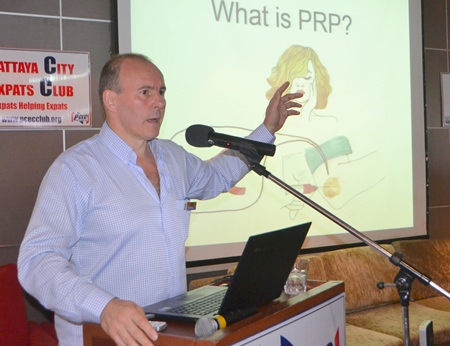 Dr. Peter Lewis explains to the PCEC what Platelet-Rich-Plasma therapy is and its benefits in relieving pain without surgery for various conditions such as osteoarthritis, bursitis and muscle tears.
Dr. Peter Lewis explains to the PCEC what Platelet-Rich-Plasma therapy is and its benefits in relieving pain without surgery for various conditions such as osteoarthritis, bursitis and muscle tears.
PRP is a process whereby the patients’ own healing cells (platelets) are used to heal injuries in joints, cartilages, ligaments and tendons. A small amount of blood is taken from the patient and then put through a centrifuge device to extract only the blood’s platelets and plasma. These are photo activated with light and then injected into the area of injury. The platelets and plasma directly assist in the healing process and also release some of the body’s natural growth factors which would otherwise not be released (to further help with the healing). Treatment usually involves a series of four injections. Peter said that numerous studies have confirmed the benefits of PRP therapy in reducing pain.
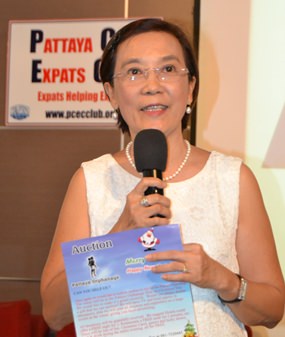 Radchada (Toy) Chomjinda from the Pattaya Orphanage invites PCEC members and guests to attend the orphanage’s annual Christmas Dinner and Party.
Radchada (Toy) Chomjinda from the Pattaya Orphanage invites PCEC members and guests to attend the orphanage’s annual Christmas Dinner and Party.
In addition, PRP is used to treat osteoarthritis, bursitis and muscle tears. It also has cosmetic uses, such as regenerating skin. Dr. Peter described PRP as an easy, quick, low-risk and non-surgical and natural procedure to shorten healing processes. He provides PRP and stem cell therapy through a network of nine clinics in Australia and Thailand operated by Surecell Medical Co. Ltd. There is one clinic in Thailand, located in Pattaya.
Dr. Peter explained that PRP therapy is one of the fastest growing areas of medicine with an annual growth rate of 200%. The number of patients per month in his clinics has gone from 50 two years ago to over 600 in each of the last three months.
Therapeutic PRP is one area in the field of regenerative medicine. Regenerative medicine involves the use of innovative medical therapies to enable the body to repair, replace, restore and regenerate damaged or diseased cells, tissues and organs. Other areas of regenerative medicine include stem cell treatment; the use of supplements, hormones and peptides; lifestyle changes, exercise and diet.
PRP has been around since the early 1990s. Before that, injections of whole blood were tried Dr. Peter explained, but did not work well. As the process evolved, PRP began to be used in sports medicine. Today, it is an accepted procedure in most fields of medicine.
Dr. Peter cautioned that PRP does not work for everyone. For some people, the damage to the cartilage or tendon, etc., is simply too severe. But, in his clinics he said the treatment has helped about 78% of patients. Between 60-70% of his patients had been told they would need surgery; Peter said that following PRP treatment 67% of them no longer needed surgery. PRP can be used in place of cortisone or Synvisc injections, which can have unwelcome side effects.
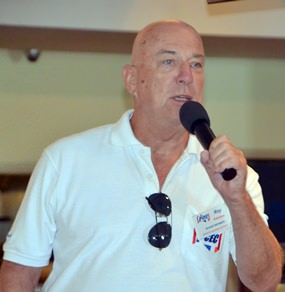 PCEC member (and chairman) Roy Albiston invites members and guests to join the Open Forum portion of the PCEC meeting by asking any questions they may have about expat living in Pattaya or providing recommendations for restaurants, good movies now playing, etc.
PCEC member (and chairman) Roy Albiston invites members and guests to join the Open Forum portion of the PCEC meeting by asking any questions they may have about expat living in Pattaya or providing recommendations for restaurants, good movies now playing, etc.
Peter introduced Fred Jackson, one of his patients. Fred, who is 66 years old, described himself as a “basket case” with very limited mobility caused by shoulder and back injuries. He said that he could not lift his left hand above his shoulder. His back injury had resulted in three discs being removed. Fred said that he had been a professional golfer but found that he could no longer golf. There were days, he said, when he couldn’t get out of bed, which caused him to miss at least one or two days of work each month. Following PRP treatment, Fred said, he has complete mobility in his arm and he hasn’t missed a day of work in six months.
Dr. Peter said that by far the most common injuries treated by PRP involve the knee. He cited one study which showed that before treatment, the largest number of patients reported a pain level of 8 on a scale of 1-10. After treatment, almost half of the patients reported pain levels of 0, 1 or 2. Females reported slightly better results than males. People in all age groups reported similar benefits.
Further, that sometimes stem cell treatment is combined with PRP treatment, especially for patients for which PRP is not effective. One advantage of stem cell therapy is that it helps rebuild the degenerated tissues. PRP therapy alone just stops the degeneration.
During the Question &Answer session, Dr. Peter explained that PRP is not usually used on children because they have enough natural growth cells to deal with injuries to cartilages, tendons, etc.
One of Peter’s colleagues said that the cost of PRP treatment will vary depending on the patient, but that on average the cost for four injections is about 100,000 baht. When stem cell therapy is combined with PRP, the average cost rises to about 275,000 baht.
After the presentation, Dr. Peter was interviewed by Paul Strachan for Pattaya Mail television. To view the You Tube Video, visit https://www.youtube.com/embed/tiHyVZHjZF4.
To conclude the program, MC Richard Silverberg updated everyone on Club activities and upcoming events and then called on Roy Albiston to conduct the Open Forum where questions are asked and answered about Expat living in Thailand, especially Pattaya.
For more information on the PCEC’s many activities, visit their website at www.pcecclub.org.
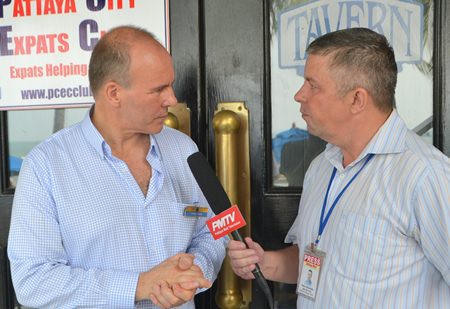 Dr. Peter Lewis after his presentation to the PCEC is interviewed by Paul Strachan with Pattaya Mail TV on the porch of the Amari’s Tavern by the Sea Restaurant.
Dr. Peter Lewis after his presentation to the PCEC is interviewed by Paul Strachan with Pattaya Mail TV on the porch of the Amari’s Tavern by the Sea Restaurant.


